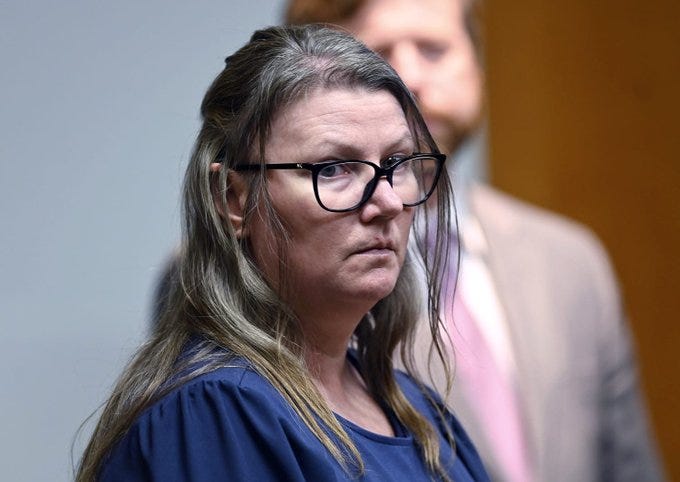Parental responsibility and five more school safety issues this week
Mother found guilty of manslaughter. Averted school shooting plot. Elementary student making threats with a loaded gun. Shootings in school parking lots.
This week, the mother of the Oxford, MI school shooter was found guilty of her actions that were links in the chain of failures that lead up to the murder of four students.
Involuntary manslaughter is defined as an unintentional killing that results from recklessness or criminal negligence, and does not require premeditation.
This is a significant case because other parents who faced criminal charges following a school shooting have been convicted of crimes that are not directly connected to murder. For example, the mother of the 6-year-old student who shot his teacher in Virginia last year was found guilty of making a false statement about her drug use during the purchase of the firearm (she used marijuana and marked “no” for illegal drug use on the ATF firearm purchase form).
Prosecutors have been forced to find technicalities to charge parents with because only 21 states have firearms storage laws that impose criminal penalties on the owner if a child accesses the weapon.
The Oxford case wasn’t the only school safety news this week:
School shooting plotted by 3 students was averted
Elementary school student threatened classmates with a loaded gun
Shootings involving “non-students” in a Georgia school parking lot during afternoon classes was actually committed by students
False alarm for active shooter goes off for the 3rd time in the same school district
More details on the major data breach of private student records by Raptor Technologies
Parent of School Shooter Found Guilty
Jennifer Crumbley was found guilty of four counts of involuntary manslaughter after her 15-year-old son committed a school shooting at Oxford High School in 2021 with a gun she purchased for him.
This sets the legal precedent for a parent to be criminally charged for leaving a gun accessible in her home. She testified that the gun was stored in a dresser drawer under a pair of jeans. She also testified that "she wouldn't have done anything differently" before the attack.
I told USA Today:
David Riedman, the founder of the K-12 School Shooting Database, said he "hope(s) that seeing a parent headed to prison will make other parents think twice before they leave a gun accessible in their home."
"Every school shooting committed by a teen who is too young to purchase a firearm would be prevented if the legal owner kept the weapon secured," Riedman said. "This verdict was critical to place responsibility on the adult who purchased the weapon . . . School shootings committed by students can't happen when kids can't access a gun."
Crumbley faces 15 years for each of the four counts and will be sentenced in April 2024.
Averted plot in Illinois
Three students were arrested for plotting a school shooting in Peoria, IL using the Discord app. Police found 29 pages of documents including drawings, building layout, and plan for stockpiling weapons.
Minutes before shooting classmates at Perry High in Iowa last month, the student assailant posted to a private Discord group chat called “School Massacres Discussion.” This is the same app that was used to plan the January 6 Insurrection and Buffalo grocery shooting.
Last month I wrote this: Discord Platform: What schools and parents need to know to prevent a school shooting
Elementary school student with loaded gun
A Florida elementary school student was arrested with a loaded handgun on February 5th after making threats and showing the weapon to other students.
The school’s principal called parents on Monday to inform them about confiscating the loaded firearm from the student. A student told staff that they saw the individual display the firearm at the school. In addition to possession, the student is accused of making harmful threats to another student.
Law enforcement was at the school to investigate the incident and the student was arrested.
Last month, a 7-year-old student at Kensington Elementary in South Carolina allegedly threatened to blow up the school and shoot his classmates. Earlier in January, a 10-year-old elementary school girl threatened to bring a gun to school to shoot multiple classmates and an 11-year-old girl threatened a school shooting.
Should threats from an elementary school student be taken more seriously? I’ve recorded 17 cases of students 10-years-old or younger firing guns on campus including the 6-year-old who deliberately shot his teacher in Richneck, VA.
Parking lot shootings during school hours
On February 1, Cobb County, GA police responded for a shooting at McEachern High during afternoon classes. The school was locked down for hours while police searched every room of the campus. Cellphone videos show a large group of teens inside the school’s fenced parking lot when the shooting happened, yet police and school officials immediately said the shooting “did not involve students”.
A week later, it turns out that both of the shooters were students at the school. The two victims who were wounded and taken to the hospital are not students. At a different Cobb County high school, a female student was arrested with 2 loaded handguns in her backpack after a tip from a classmate.
Why did school officials emphasize the shooting didn’t involve students?
Did these two students have handguns with them all day at school?
Since Uvalde, Georgia is spending +$100 million per year of surplus tax funds for increasing campus security with CCTV, metal/object detectors, access control, panic buttons, fortified doors, and ballistic shields. If a large group of teens—both students and non-students—can congregate inside the fenced school campus during school hours, how is this security tech going to stop a carefully planned attack?
Another school parking lot shooting in Austin, TX on January 29 highlights the same problems. A current student armed with an AK-47 and a handgun shot a former student—who was hanging out on campus during lunch—in the school parking lot and then ran him over with a car.
Shooter and victim (who was not a student at the school) had an ongoing dispute over a female student. An SRO was at the school when the shooting happened. School officials sent a letter to parents explaining there was no danger to other students despite shots fired and reckless driving in the parking lot.
For the last 60 years, school parking lots have been the most common location for a shooting on campus. Some questions for school officials to consider:
Are non-students allowed on the campus during lunch and school hours?
Does the campus security plan include the parking lot?
Is there a written plan or training exercise for a shooting in the parking lot?
Does the SRO patrol the parking lot during the school day?
Does the threat assessment team and school security staff keep track of escalating disputes between current and former students?
False Alarm for Active Shooter
For the third time this school year, a Troy Schools (NY) employee set off the active shooter alarm causing panic on campus.
Unlike fire alarms, there are no national standards for how these active shooter alert systems work. The alarm used by Troy Schools is triggered by a keyboard shortcut. These systems should have user testing to make sure they aren’t too easy to activate by mistake, but without standards it’s up to the vendors to self-regulate.
Emergency alerts were the topic of multiple findings and recommendations in the DOJ report on the Uvalde school shooting. The Raptor Technology system used by Uvalde schools required staff to have cell service, see the alert on their phones, and then log-in to an app to read the message.
Raptor Technology (again) Data Breach
4,600 school districts across the country use Raptor Technology—the self-proclaimed “gold standard” in school safety—for tracking threat assessments of students, storing emergency plans, logging visitors, and sending emergency alerts. The company claims to encrypt student records but instead was publishing PDFs to an open website.
If you pasted the file name into your internet browser, private student records would open up. Despite claims that data was encrypted, Raptor posted 4,000,000 PDF files with sensitive data that were accessible to anyone in the world with internet access.
Info in open-access PDF documents included:
Names of students who looked ‘unkempt or hungry', withdrawn from friends, have poor concentration, or struggle academically
Names of students who engage in self-harm
Drivers licenses of school visitors
Active shooter response plans
Campus maps and CCTV locations
Locations and descriptions of "safe rooms"
Emergency contact lists
The 74 Million published a detailed article about the Raptor’s data breach and the impact on the Education Technology Privacy Pledge that vendors including Raptor have signed.
Schools across the country depend on the marketing claims of security vendors to keep students and staff safe. Are these companies telling the truth about how their technology works?
Please subscribe, like, and share this story so that I get feedback on the type of content that you find most useful.
David Riedman is the creator of the K-12 School Shooting Database and a national expert on school shootings. Listen to my recent interviews on Freakonomics Radio, New England Journal of Medicine, and Iowa Public Radio the day after the Perry High shooting.







